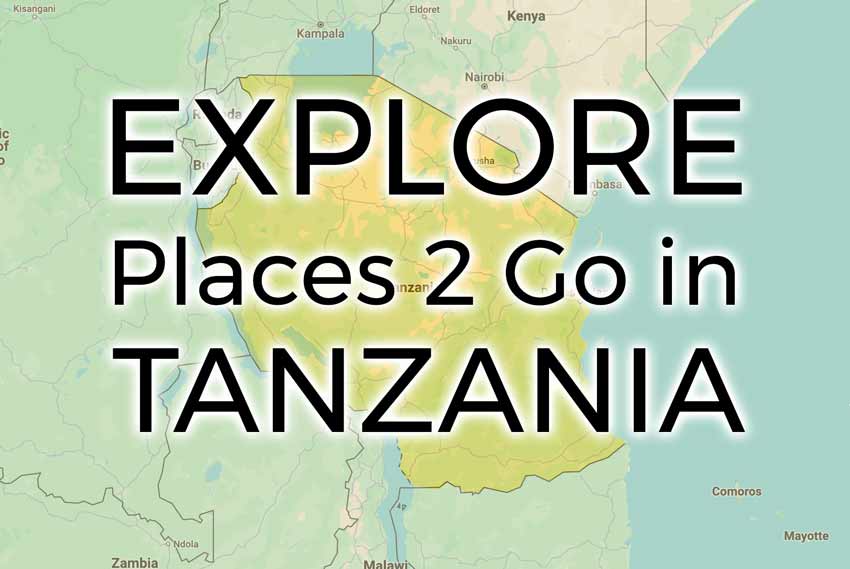Description: The smallest of Tanzania’s national parks, Gombe is a narrow strip of chimpanzee habitat on the shore of Lake Tanganyika. Its chimpanzees – habituated to human visitors – were made famous by the pioneering work of Jane Goodall’s studies. The matriarch, Fifi, the last surviving member of the original community, only three years old when Goodall first set foot in Gombe, is still regularly seen by visitors. Tracking the chimps is a fascinating experience.
It’s likely that you will observe them grooming each other in small groups, squabbling noisily, or bounding from tree to tree swinging on vines. Watching a mother chimp with her offspring is truly remarkable. Difficult to reach and relatively expensive, Gombe has few visitors each year.
Location: Just north of Kigoma, on the shore of Lake Tanganyika. Usually requires flight with Precision Air from Dar es Salaam (daily) or a shared charter flight from Arusha that flies on Tuesdays and Fridays only. A train (takes 2-3 days) from Dar might be possible.
Things 2 Do: Chimpanzee tracking, hiking, swimming/snorkeling, night walks
Time: Set aside at least 4 days (1 to get there, 1 to return and at least 2 nights actually in the park).
Animals: Chimpanzees, baboons, red-tailed and red colobus monkeys, more than 200 bird species.
Accommodations
$
TANAPA bandas
$$$
Kigoma Hilltop
Gombe National Park Tours – A Journey into Tanzania’s Primate Paradise
What makes a place so extraordinary that travelers journey across continents to see it? For many, the answer lies in the wild, untouched corners of Africa where nature still rules supreme. Among these rare sanctuaries, Gombe National Park stands out as one of Tanzania’s most unique treasures. Known worldwide for its chimpanzees and the groundbreaking research of Jane Goodall, Gombe continues to fascinate wildlife lovers seeking an intimate encounter with primates and the raw beauty of Lake Tanganyika.
Introduction to Gombe National Park Tours
Gombe National Park is Tanzania’s smallest national park, yet it holds some of the most remarkable wildlife experiences in Africa. This narrow strip of forest stretches along the eastern shore of Lake Tanganyika, one of the world’s deepest and oldest lakes. Despite its modest size, the park is globally recognized for chimpanzee research that began in the 1960s and continues to this day. Visitors on Gombe National Park tours step into a living laboratory of primate behavior while enjoying the scenic beauty of a lakeside wilderness.
Unlike the more famous safari destinations of Serengeti or Ngorongoro, Gombe is not about vast savannahs or large herds of game. Instead, it offers something far more personal – the chance to follow a chimpanzee troop through dense forest trails, to sit quietly as they groom one another, and to witness their intelligence and social bonds up close.
The Experience of Tracking Chimpanzees
Chimpanzee tracking is the highlight of Gombe National Park tours. It is both physically demanding and emotionally rewarding. Rangers lead small groups into the forest, often following the calls of chimps echoing through the canopy. The reward may be observing them squabbling loudly, playfully swinging between vines, or tenderly caring for their young.
Watching a mother chimp guide her infant or seeing a group gather to groom each other offers insight into behaviors strikingly similar to our own. The trek itself is part of the adventure – steep forest paths, rustling vegetation, and sudden glimpses of wildlife that remind you that you are walking in a wild and untamed habitat.
Beyond Chimpanzees – Wildlife and Birdlife
Although chimpanzees are the main draw, Gombe is home to a variety of other wildlife. Troops of olive baboons are often seen near the park entrance, while red-tailed and red colobus monkeys swing through the forest. The park also hosts more than 200 species of birds, making it a rewarding destination for birdwatchers. From the iridescent Peter’s twinspot to fish eagles perched along the lakeshore, birdlife adds color and constant movement to the forest.
Aquatic life also thrives in Lake Tanganyika. Travelers can enjoy swimming and snorkeling in its clear waters, where colorful cichlid fish dart among rocks. Night walks in the park bring another dimension, offering glimpses of nocturnal creatures and the forest’s vibrant sounds after dark.
Location and Accessibility
Reaching Gombe requires effort, but the journey is part of its charm. The park lies just north of Kigoma on Lake Tanganyika’s shore. Travelers typically fly from Dar es Salaam with Precision Air or take shared charter flights from Arusha twice a week. For those seeking an adventurous route, the train from Dar es Salaam to Kigoma takes two to three days, followed by a boat ride along the lake to the park.
This relative inaccessibility means that Gombe receives fewer visitors than other Tanzanian parks, ensuring a more intimate experience. For many travelers, this exclusivity is exactly what makes Gombe National Park tours so appealing.
How Many Days to Spend in Gombe
To fully enjoy the park, travelers should plan at least four days. One day is usually spent reaching Kigoma, another for the return journey, and at least two nights within the park itself. This allows enough time for multiple chimpanzee tracking treks, relaxation by the lakeshore, and additional activities such as hiking or snorkeling.
Accommodations During Gombe National Park Tours
Accommodation options in and around Gombe range from simple to luxurious. Budget travelers often choose TANAPA bandas, basic park-run huts that offer comfort at affordable rates. For mid-range travelers, Kigoma Hilltop provides a blend of comfort and convenience near the lakeside town. For those seeking a premium experience, Mbali Mbali Gombe Lodge offers luxury in a pristine setting, with breathtaking views over Lake Tanganyika.
Wherever you stay, the focus remains on immersion in nature and easy access to the park’s main activity; chimpanzee tracking.
Best Time for Gombe National Park Tours
Gombe can be visited year-round, but each season offers different experiences. The dry season, from June to October, makes hiking easier and provides the best chance of spotting chimpanzees as they remain closer to the trails. The wet season, from November to May, transforms the forest into a lush green paradise and is ideal for birdwatchers, although trails can be slippery.
For travelers whose priority is chimpanzee tracking, the dry months are most recommended, while nature lovers who enjoy fewer crowds and abundant birdlife may prefer the wetter months.
Why Choose Access 2 Tanzania for Gombe National Park Tours
Planning a journey to Gombe requires expertise due to its remoteness and unique logistics. Access 2 Tanzania specializes in crafting personalized itineraries that combine chimpanzee tracking with other Tanzanian highlights, such as Serengeti safaris or Zanzibar beach stays. With experienced guides, well-organized transport, and insider knowledge, Access 2 Tanzania ensures that every visitor enjoys a seamless and unforgettable adventure.
From booking domestic flights to arranging boat transfers, accommodations, and guided treks, every detail is carefully managed. This allows travelers to focus on the experience itself rather than the challenges of reaching such a remote location.
FAQs about Gombe National Park Tours
Q1: What is Gombe National Park best known for?
Gombe is best known for its chimpanzee populations and the groundbreaking research conducted by Jane Goodall. Visitors can track habituated chimps and observe their natural behaviors in a forest environment alongside Lake Tanganyika.
Q2: How do I get to Gombe National Park?
Most travelers fly from Dar es Salaam to Kigoma and then take a boat along Lake Tanganyika to the park. Charter flights from Arusha are available twice a week. Train journeys are possible but take several days.
Q3: How difficult is chimpanzee tracking?
Chimpanzee tracking can be moderately challenging, involving steep trails and dense forest. A reasonable level of fitness is recommended. However, the effort is well rewarded with intimate encounters with chimpanzees in their natural habitat.
Q4: What animals can I see besides chimpanzees?
In addition to chimpanzees, Gombe is home to olive baboons, red colobus monkeys, red-tailed monkeys, and over 200 bird species. Aquatic life in Lake Tanganyika also adds to the diversity of the experience.
Q5: How many days should I plan for a visit?
At least four days are recommended – one to travel there, one to return, and at least two nights in the park to track chimpanzees and enjoy activities like hiking, swimming, or snorkeling.
Q6: Is Gombe suitable for families with children?
Families can visit, but chimpanzee tracking has a minimum age requirement of 15 years for safety and conservation reasons. Younger children can enjoy the lakeside setting and shorter hikes.
Q7: When is the best time to visit Gombe National Park?
The dry season from June to October offers the best conditions for chimpanzee tracking. The wet season from November to May is excellent for birdwatching and provides a greener forest environment, though trails can be slippery.
“Excellent! Very professional with a knowledgeable guide and good itinerary for Safari.”


